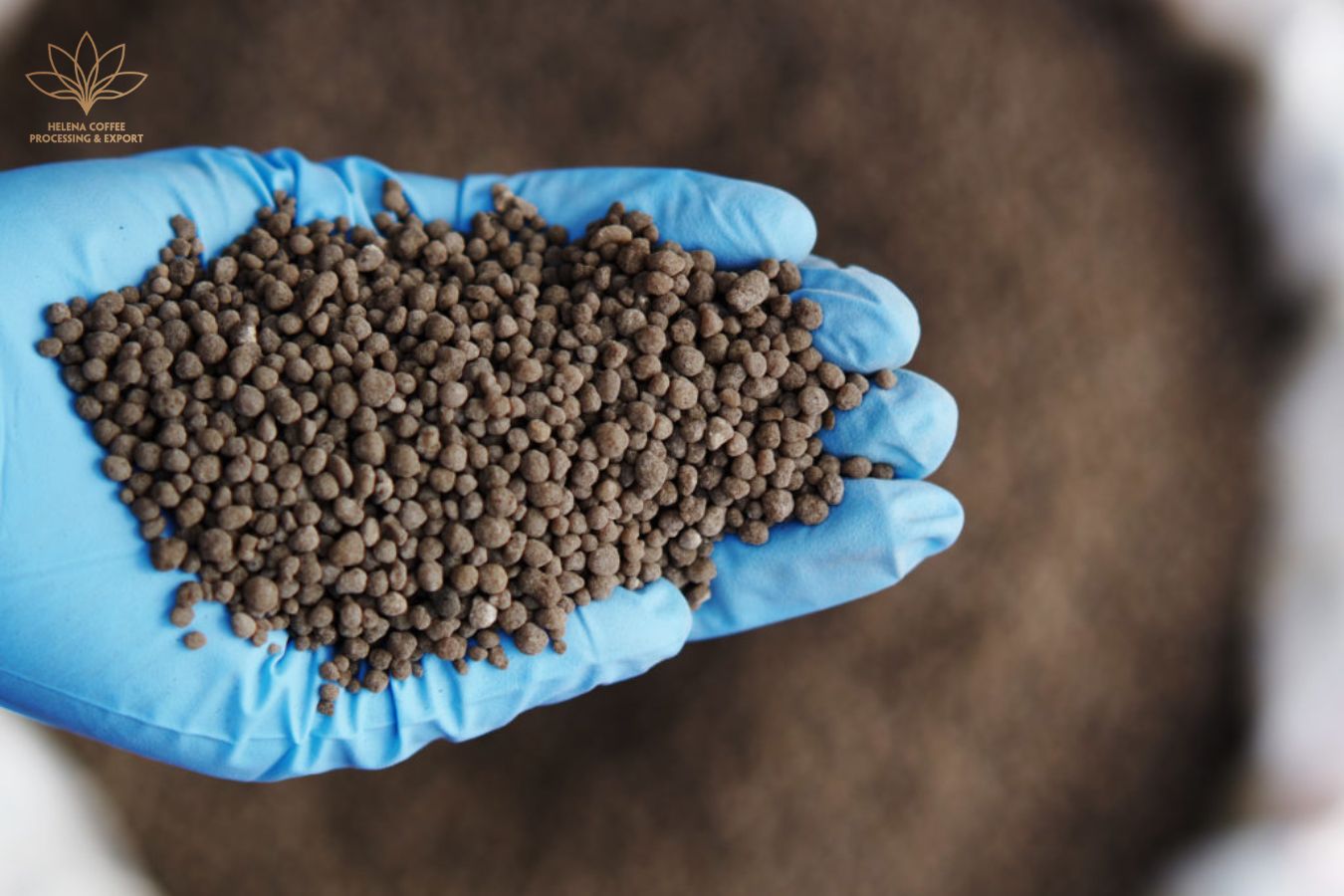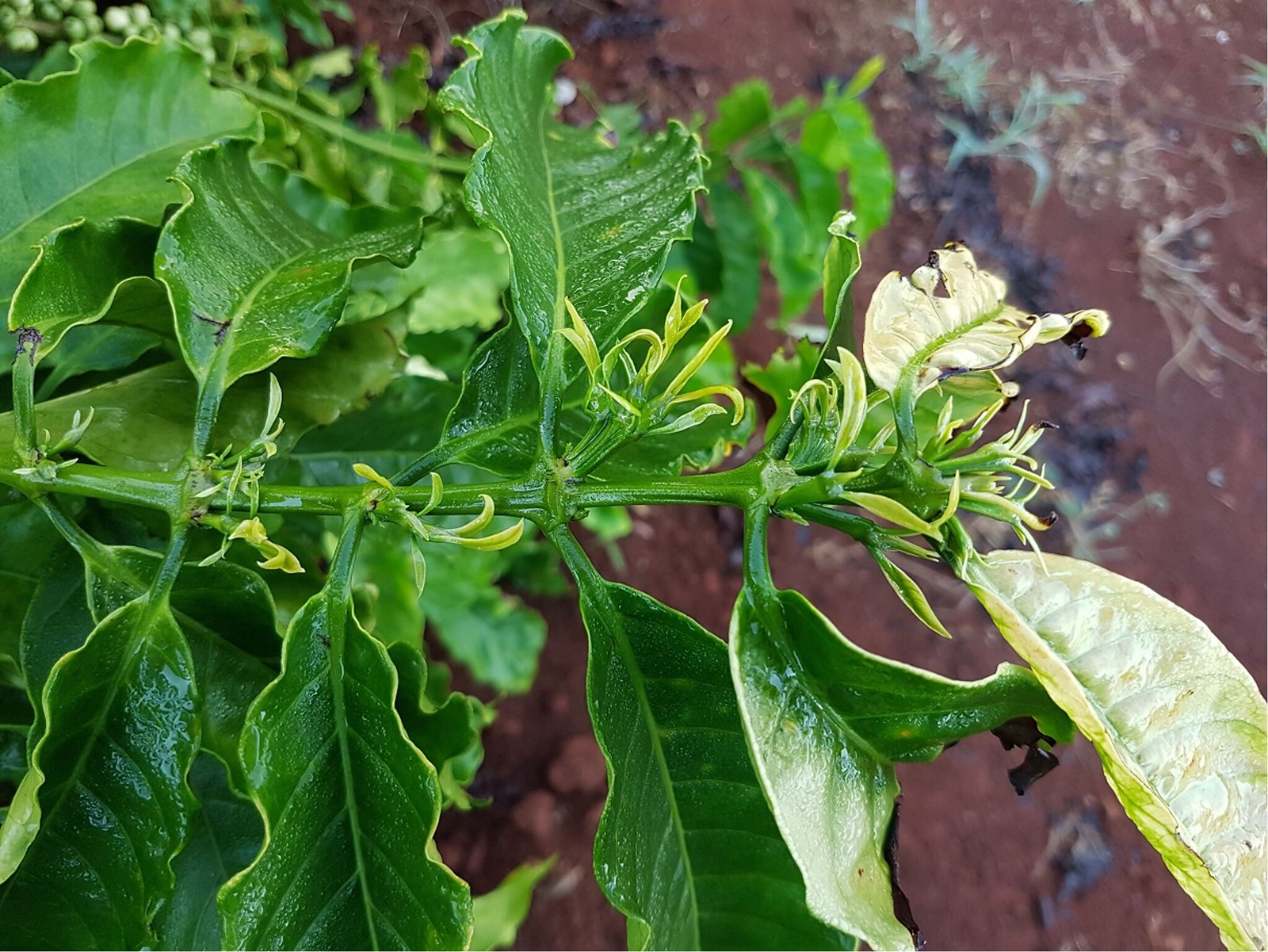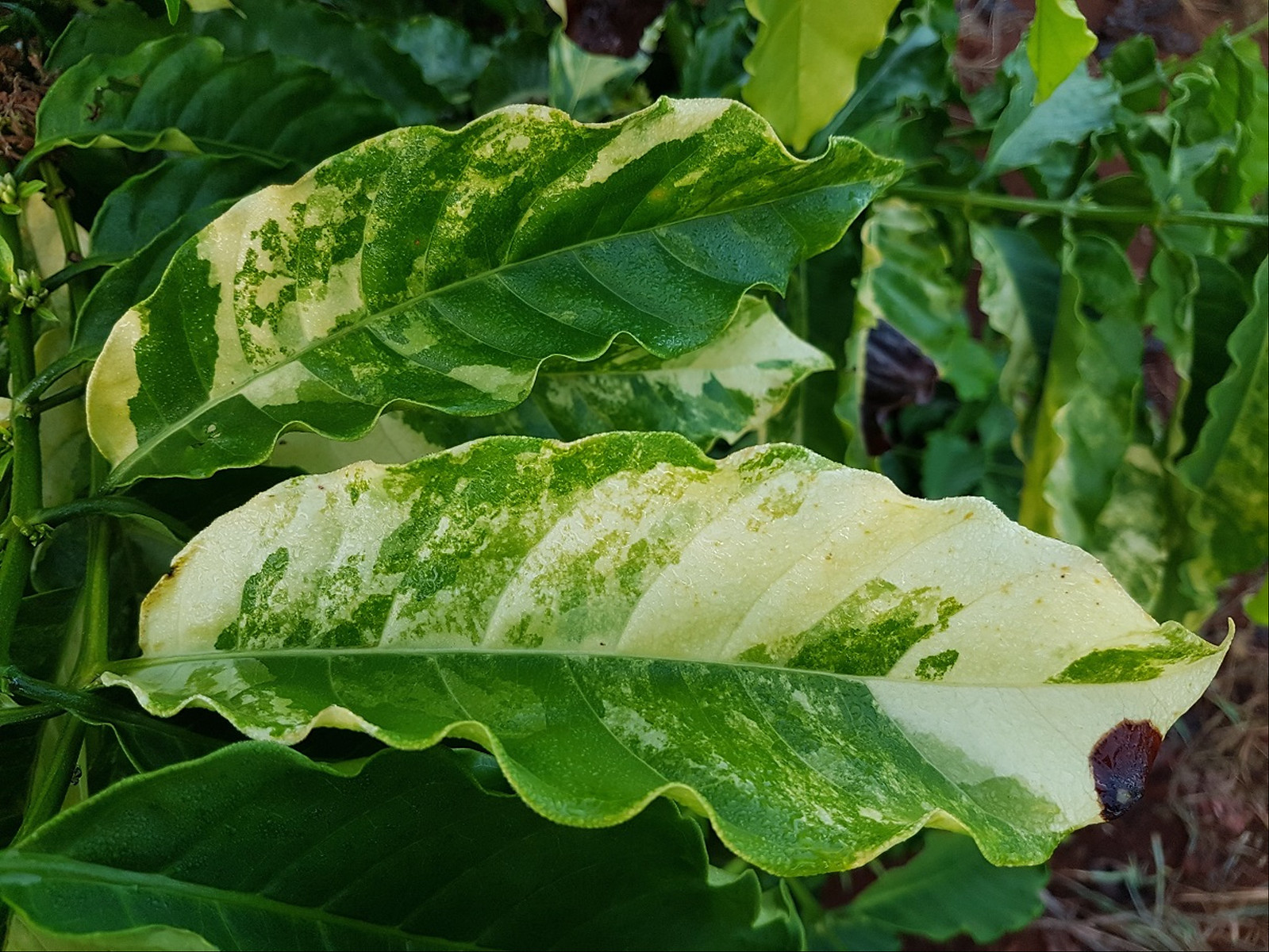
Coffee Farming: Nutrition & fertilizer for coffee plants – Whole Farming is a particular column from Helena Coffee Vietnam that provides an overview of what you can and can’t control and how to exercise what holds you can to create a sustainable crop and a good cup of coffee.
Plants can make their food from sunlight and carbon dioxide (through photosynthesis and respiration). However, to do so, they must be supplied with a certain amount of nutrients from the soil.
If there is a lack of nutrients in the soil, it limits the growth and yield of the plant, even if other growing conditions are ideal.
This post is intended to give an overview of the essential nutritional needs of coffee plants, not to call for using fertilizers in coffee cultivation.
To be able to apply to production, you need to consult local agricultural experts or better understand the role of fertilizers & fertilization methods in the document “Nutrition Management for Coffee Plants.”
This is part of the excerpt from “Chapter 2: Farming Techniques / Soil and Fertilizer” in the book Coffee Trees in Vietnam by BMT Coffee Association, 2021.

Fertilizing plants means adding nutrients to the soil to support plant growth, fight certain diseases, or increase yields. Fertilizers can be of natural origins, such as manure, compost, or synthetic.
Using fertilizers can significantly affect yields and make inefficient soils suitable for cultivation. Still, it can harm the environment (whether natural or synthetic) if their use is not carefully controlled.
Fertilizers can be significantly expensive, and as a significant barrier for farmers, there are plenty of guidelines and reports with false information – in some cases, fake fertilizers are sold more commonly than “real” fertilizers.
Therefore, we only approach a summary of the inputs common on coffee farms but the terroir of each region is different, so there will not be a common solution for all.
Essential nutritional elements for coffee plants
Coffee plants need 16 essential elements for proper nutrition. They can be divided into four groups, based on their function and importance.
- Group 1: Carbon, Oxygen, and Hydrogen. These elements are present in water and air, which are used by plants during photosynthesis to produce glucose.
- Group 2: Nitrogen, phosphorus, and potassium (N, P, K). These substances are also known as “macronutrients”, healthy coffee plants need them in large amounts.
- Group 3: Calcium, magnesium, and sulfur. They are called “medium nutrients”, because they are needed in fewer quantities than macronutrients.
- Group 4: Zinc, boron, manganese, molybdenum, iron, copper, and chlorine. They are called “trace elements”, as they need less – although they are still necessary for the nutrition of the coffee plant.
Fertilizers can be used to ensure an adequate supply of elements in groups 2 to 4. To be useful to plants, these elements must be present in a form that plants can absorb from the soil – for example, nitrogen.
Plants cannot use atmospheric nitrogen gas until it is “fixed” in the soil in the form of water-soluble nitrogen compounds such as nitrates.
A principle in agricultural science developed by Carl Sprengel (1840) and later popularized by Justus von Liebig mentions that: The growth of crops is not determined by the total number of available resources, but by the scarcest resources (limiting factors).
In other words, plant growth is limited by the least amount of nutrients available, it doesn’t matter how much other nutrients are available to the plant. This is clearly illustrated in the example of wooden crates below.

Plants require a different proportion of all the elements necessary for growth. If one of these elements is relatively deficient, it limits plant growth.
For example, if the soil is low in nitrogen, then plant growth will be limited by the amount of nitrogen the soil can provide – no matter how good the growing conditions are in any way.
Macronutrients
Nitrogen (N)
Nitrogen is the most important nutrient in coffee production, with yield loss rates of up to 60% reported when no additional fertilizers are used.
The nitrogen needs of crops increase as they grow – however the supply of nitrogen in the early stages of growth also affects subsequent yields.
The content of N in coffee plants varies from 1.5 – 3.0% of dry weight, in seeds containing from 2.9 – 3.5%; in leaves from 1.5 – 3.5%.
Nitrogen is obtained from the soil by plants in the form of NH4+ and NO3–, which then combines with compounds that the plant assimilates thanks to the energy of sunlight to form amino acids and proteins.
Protein is the driving force for the growth process of coffee including the process of forming yields.
Coffee planted with direct lighting without shade trees) needs more N than coffee planted with shade trees – covered by shaded flora.
Since planting entirely in the sun often triggers a strong and concentrated flowering mechanism, it is likely to produce higher yields than shaded plants, moreover coffee in bare gardens does not enjoy the N provided by shade plants.
Therefore, in shaded gardens when fertilized with high N fertilizer, it is often not as effective as in gardens without shade. In thickly shaded gardens, coffee yields react poorly to nitrogen fertilization.


Coffee trees need the most N in the rainy season when the fruit grows and also the season of creating new branches and leaves for the next year.
If there is not enough N supply at this time, N will focus on fruit farming, nutritional growth almost stops, poor storage branching, and lead to a decrease in yield in the next crop.
On the other hand, the excess protein will make coffee trees and fruits accumulate a lot of water, reducing resistance to unfavorable conditions as well as pests and diseases; productivity, and product quality decreased
Nitrogen is usually added to the soil in the form of chemical fertilizers, most commonly ammonium nitrate (NH4FULL3) and urea (CO(NH)2)2).
Nitrogen can also be added to the soil by adding animal manure – this is probably the first known fertilizer. Nitrogen-fixing bacteria are concentrated in the roots of some crops such as legumes, and so these plants can be grown specifically to increase the amount of nitrogen in the soil.
Phosphorus (P)
Along with nitrogen, phosphorus is a major nutrient commonly found in coffee plants. For example, the soil in southern Ethiopia, where the Arabica plant originates, has a high content of all essential elements except nitrogen and phosphorus.
Compared to nitrogen, phosphorus is relatively immobile in the soil. This means that the phosphorus levels around the roots will be responsible for the yield, rather than the amount of phosphorus present in the soil as a whole.
Phosphorus absorption can be improved by combining with “root symbiosis fungi”. Symbiotic fungi such as mycorrhizae facilitate water and nutrient absorption in plants, and plants provide food and nutrients produced by photosynthesis to fungi.


On the other hand, since nitrogen is more mobile in the soil, changing the distance between plants can alter the balance of N and P needed. Due to the limited mobility in the soil, the excess phosphorus added to the fertilizer can gradually accumulate in the soil.


The phenomenon of phosphorus deficiency commonly seen in coffee gardens after harvesting is a problem that should not be a concern.
A good watering will correct this phenomenon. In case of severe deficiency, potassium phosphate compounds can be used (KH2PO4 or K2HPO4) with a concentration of 0.3 – 0.4% to spray coffee twice, 2-20 days apart to quickly treat this symptom.
Applying phosphate fertilizer too much, specially fused phosphorus will make coffee yield not increase, sometimes on the contrary because phosphorus will inhibit the absorption of zinc in coffee and antagonize potassium in the soil, in plants through the content of Ca, Mg contained in the fertilizer in a significantly high amount.
Potassium (K)
Although potassium is generally less restricted than nitrogen and phosphorus in most coffee soils, it is still an important nutrient.
If fertilizers containing only N and P are added to the soil, then increased plant growth leads to an increased need for potassium, which can then become an essential nutrient.
Trials in Ethiopia have shown some effect of moderate potash fertilization on increasing yields.
Potassium is particularly important in growing high-quality fruit – which affects color, shape, and sugariness.
Plants will absorb more potassium than they need to grow healthy, and while this may improve fruit quality, it doesn’t have a measurable effect on yields — we just need coffee beans.
During the period of fruit development until the fruit matures and ripens the need for potassium in the plant increases, and the potassium content in the leaves can be significantly reduced due to being transported from the leaves into the fruit.
This is clearly seen in branches bearing many fruits with a lower potassium content in the leaves than those stored on the same tree (Zhang Hong, 1996).

Potassium deficiency often manifests itself in old leaves, on the branches of which carry many fruits. Brown streaks usually appear at the edge of the leaf, then gradually spread into the middle of the leaf blade, eventually falling off.
The period when the coffee tree bears fruit if it is lacking, the fruit falls a lot, the peel is gray-brown, when ripe the fruit is yellow-red-brown, dry, and not juicy, the color is not fresh, the kernel is smaller than usual.
Potassium is involved in the activity of more than 60 enzymes, helps in the formation and transport of carbohydrates, and participates in the synthesis of proteins and organic compounds in plants.
Potassium increases the ability of plants to absorb water, helping plants increase drought tolerance, cold tolerance, and salt tolerance. Adequate application of potassium helps the plant to suck up other nutrients better.
Potassium has the effect of reducing the rate of fruit loss, increasing fruit weight and kernel weight, thus increasing the commercial value, while also helping the plant to be less susceptible to pests and diseases due to stronger growth.
Medium and trace nutrients
Trace nutrients, such as zinc, magnesium, boron, iron, and copper, all play small but important roles in maintaining proper plant function. A deficiency of these elements can lead to various physical symptoms in coffee plants.
They are usually only replenished after a long period of intensive cultivation or when symptoms of a specific deficiency appear – such as young leaves having an unusual copper color due to calcium deficiency.
Calcium (Ca)
Calcium is mainly involved in cell structure, increases environmental resistance, and increases the resistance of plants to aluminum and manganese toxins. Ca content in coffee leaves ranges from 0.5 – 1.2%, and in beans from 0.4 – 0.7%. Coffee plants absorb calcium in the form of Ca ions2+.
Most coffee plantations have a sufficient amount of effective calcium in the soil to meet the needs of coffee. The application of fused phosphate or calcium nitrate nitrogen (Ca(NO)3)2) annually also adds a significant amount of calcium to the plant.

In case of calcium deficiency, lime can be applied at a dosage of 500-700 kg/ha, every 2-3 years; or apply dolomite flour, the amount is from 2,000 to 2,500 kg/ha.
The phenomenon of calcium deficiency in coffee is rare. However, when young leaves are missing, yellowing from the edge of the leaf spreads gradually into the middle of the leaf blade.
The leaves are slightly dark green along the sides of the main veins of the leaf, sometimes very pale green. When severe, old leaves also have the same symptoms.
Coffee leaves with calcium deficiency have a Ca content in the leaves from 0.4 to 0.7%. Lack of Ca also makes the cell wall thin, so it is easy to be harmed by insects and fungi.
Magnesium (Mg)
Magnesium is the main ingredient in chlorophyll, which is the plant that absorbs solar energy to synthesize organic matter through photosynthesis. Magnesium is also involved in enzymatic reactions involved in the energy metabolism of plants.
Coffee plants absorb magnesium in the form of Mg2+ ions. The magnesium
content in leaves varies from 0.3 – 0.%, in seeds from 0.2 – 0.35%.

Symptoms of magnesium deficiency are detected on coffee plants in old, yellow leaves starting from the secondary or primary tendon, then gradually spreading to the edge of the leaf.
Along the main and secondary tendons remain, and blue streaks form a blue herringbone shape on a yellow background. Then the leaves turn dark yellow or brown and then fall off.
When magnesium deficiency the mg content in the leaves fluctuates between 0.15 – 0.25%. The quickest cure for magnesium deficiency is to spray magnesium nitrate (Mg(NO3)2) or magnesium sulfate (MgSO4) concentration of 0.2 – 0.4% 2 – 3 times 15 – 20 days apart.
Sulfur (S)
Sulfur involved in the formation of chloride is an important component of chlorophyll that plays a huge role in the synthesis of organic compounds thanks to the energy of sunlight.
Sulfur participates in the synthesis of 3 amino acids to form proteins, activate the yeast, and synthesize vitamins … Especially sulfur participates in the composition of aromatic compounds for coffee beans, enhancing the drought and heat resistance of coffee.
Sulfur is absorbed through the roots in form I on SO42-. S content in leaves varies from 0.09 – 0.14%, and in seeds from 0.12 – 0.16%. Sulfur deficiency often manifests itself in young leaves on the tops (often called albinism).
The leaves are yellow or silvery white, the leaves may be slightly smaller than normal, and the young leaves are silvery white.

It should be distinguished from the case of protein-deficient coffee that the old leaves
are yellowed or the leaves are yellowed throughout the plant.
The phenomenon of sulfur deficiency often appears in basic coffee gardens at the end of the dry season and at the beginning of the rainy season.
For prevention, annually apply a quantity of sulfur-based fertilizers such as SA or zinc-emitting sun with the corresponding amount of 20-30 kg S.
Use SA solution with a concentration of 0.30 – 0.50%; or zinc spray 2 times 15-20 days apart to cure sulfur deficiency for coffee. It is also possible to use S-containing foliar fertilizers to spray coffee to prevent this phenomenon.
Bo (B)
Bo has a role in increasing the number of stings, the number of branches in reserve, increasing the number of flower sprouts.
Boron also has the effect of stimulating the germination of pollen grains, and the growth of chalk bags, helping the process of fruit formation to occur smoothly. Coffee plants absorb boron in B forms4O7 2-HBO32- and BO33-.

B deficiency usually occurs on gray soils with a light mechanized composition.
When there is a B deficiency, coffee leaves are smaller and shorter, the edges are not normal, the top shoots are often dry, and the branches are horizontal or dead.
The phenomenon of secondary branches growing in bunches in the shape of fan turns. The leaves are olive green or light yellow-green in the second half of the leaves.
If the plant is deficient in boron, the B content in the leaves is about 15-25 ppm. To overcome this, care should be taken to apply to the soil about 10-20 g of borax (Na3B4O7)/tree/year.
Or spray borax with a concentration of 0.4%, or boric acid (H3BORON3) concentration of 0.3%, spray 2 times 20-25 days apart for fast effect.
Zinc (Zn)
Zinc increases drought resistance, and heat resistance and promotes the use and metabolism of nitrogen and phosphorus in plants.
Zinc plays an important role in the process of differentiation of flower sprouts, pollination, fertilization, and fruit formation. Coffee plants absorb Zn in the form of Zn 2+ ions or zinc in chelate form.

Symptoms of zinc deficiency manifest themselves first on the tops or young leaves at the tips of the branches. The leaves are smaller than normal, the edges of the leaves are curved on both sides and have a lanceolate shape, the leaves are light yellowish-green, and the burning is shortened, so it is often called neck drop.
Zinc deficiency usually appears in the 7th, 8th, and 9th months, sometimes all year round. Zinc deficiency of coffee plants does not differentiate flower sprouts, limiting the pollination ability of flowers, the rate of flowers falling and falling fruits is very high, sometimes up to 70-90%; The branches dry out, resulting in reduced yields, gray beans, and poor cup coffee quality.
To overcome this, it is necessary to add zinc-containing fertilizers periodically to meet the needs of the plant. In case of zinc deficiency, zinc sulfate solution (ZnSO4.7H2O) should be sprayed with a concentration of 0.3 – 0.5% 6.7 months from 2 to 3 times 20-25 days apart.
This measure is fast-acting. It can be applied to the soil in the amount of 15-25 kg ZnSO4.7H2O / ha.
Iron (Fe)
Iron has no obvious role in the growth and development of coffee. Iron only makes the color of coffee beans more beautiful.
Coffee plants absorb iron in the form of Fe 2+ and Fe 3+ ions.

Iron deficiency the young leaves turn slightly yellow, but the veins are still green in the form of meshes. Iron deficiency coffee beans can be yellow or colored.
When iron is deficient, the Fe content in the leaves varies from 15 to 35 ppm. For prevention, iron chelate or iron sulfur spray (FeSO4.nH2O) is more effective than spraying, the amount of application is from 15 to 20 g / plant.
Manganese (Mn)
Manganese (Mn) has a role in promoting better photosynthesis of plants. On soils with low pH, it is rare to have a lack of liver gills. However, for very acidic soils, Manganese poisoning is easy to occur.
Smoked coffee plants carry liver in the form of Mn 2+ ions. Without liver gills, the leaves at the tips of the branches (the last pair of mature leaves) go from bluish-yellow to lemon-peel yellow.

This symptom usually appears at the tips of the leaves, then gradually spreads out in larger leaf areas. In case of severe deficiency, the leaves are green with yellow-white streaks.
Coffee grown on basalt red-brown soils or other red-yellow soils rarely shows symptoms of deficiency of this element. For prevention, when Mn deficiency can spray 4.0% Manganese sulfur solution (MnSO4) along with Ca(OH)2 lime water 0.2% is the fastest effect.
Notes on nutritional supplements for coffee plants
The phenomenon of lack of elements N, P, K, Ca, Mg, S, Zn, B … for coffee plants not only due to lack or insufficient fertilization of those elements, but also due to applying too high amounts of fertilizer, but a serious imbalance between nutrient elements (as stated in the example of wooden barrels).
In case of too high nitrogen application, coffee plants cannot absorb potassium, so it leads to the phenomenon of potassium deficiency.
Or sometimes applying nitrogen in high amounts for many years continuously causes soil acidity, high content of mobile aluminum in the soil inhibits the nutrient absorption of the root system or causes rot of the roots head, leading to nutrient deficiency for plants, in which nitrogen is shown first.

Depending on the nutrient needs of the plant in each stage, the coffee plant exhibits specific symptoms of lack of nutrition of each element.
For example, when a coffee tree has a root disease during the period of rapid fruit growth, the symptoms of potassium deficiency will show first, or sometimes the plant will show many symptoms at the same time.
Applying high potassium disproportionately to nitrogen, coffee plants are likely to be deficient in calcium or magnesium. If the phosphorus is high, the coffee plant is not able to absorb zinc.
Applying phosphate fused in high doses for many years continuously, coffee plants are prone to potassium deficiency, and zinc deficiency …
Also note that when coffee plants suffer from root diseases, symptoms of lack of protein, phosphorus, and potassium magnesium are easy to appear.
Therefore, when symptoms of malnutrition occur from coffee, it is necessary to fully consider subjective factors (due to fertilization) or objects such as the disease situation, especially coffee root diseases to have timely and effective treatment.
Natural and synthetic fertilizers
Both natural and synthetic fertilizers (or chemical fertilizers) are commonly used by coffee growers. Natural fertilizers are considered better for the environment and have a low capital cost (although they may require a lot of labor).
Compost can also have additional benefits, such as improving soil structure or increasing soil biodiversity, both of which can help plants grow.
In many coffee-growing regions, they are the only form of fertilizer that is used regularly, as farmers do not have access to chemical fertilizers.
Natural fertilizers include manure, compost, and, in the case of coffee, fermented coffee grounds. Using waste coffee grounds and compost will return some of the nutrients lost for coffee growth back to the soil.
However, these interventions are not enough to maximize productivity. To achieve the typically recommended nitrogen fertilization rate of 150 kg/ha, 30 tons of compost stolen from organic waste is required.
The most common synthetic fertilizer consists of several combinations of N, P, and K. Nitrogen gas in the air is fixed to ammonium by the Haber Process, in which nitrogen reacts with hydrogen under high temperature and pressure, using a metal catalyst.
The invention of this process ushered in the era of synthetic fertilizers and, as a result, allowed a significant increase in the population. Scientists estimate that the Haber-based ammonia fertilizer industry has helped maintain food sources for about a third of the Earth’s population.
In coffee, the most commonly used chemicals derived from this process are urea (which provides N), ammonium phosphate and diammonium phosphate (DAP) which help provide P, and when adding some potassium salts such as potassium chloride we have NPK fertilizer.
Chemical fertilizers can increase yields significantly, despite their high cost and a hindrance to many farmers, but in many cases can increase profits for farmers.
However, when used in excess they can cause a serious impact on the environment. To better understand the role of fertilizers, and methods of fertilizing coffee plants you can download the document “Nutrition Management for Coffee Plants“.
This is an excerpt from Chapter 2: Farming Techniques/Soil and Fertilizer, in the book Coffee Crops in Vietnam by BMT Coffee Association, 2021.
References:
- Primecoffea, Canh tác 10: Dinh dưỡng & phân bón cho cây cà phê, Tháng Một 20, 2023.
